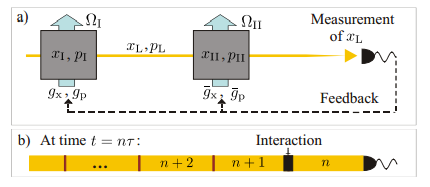Physicists Discover the Secret of Quantum Remote Control
The ability to control one quantum particle by manipulating another somewhere else sounds like the stuff of science fiction. Now physicists say they know how to do it


Teleportation is one of the more extraordinary phenomena in the quantum world. It allows a quantum object, such as a photon or electron, to travel from one location to another without passing through the space in between.
Teleportation is a standard procedure in any decent quantum mechanics laboratory. Physicists use it on a daily basis for quantum communication and quantum computation.
This story is only available to subscribers.
Don’t settle for half the story.
Get paywall-free access to technology news for the here and now.
Subscribe now
Already a subscriber?
Sign in
If that sounds exotic, you ain’t seen nothing yet; teleportation is about to get a whole lot weirder. That’s because until now, physicists have only been able to teleport single particles, one at a time. Today, Christine Muschik at the Mediterranean Technology Park in Barcelona and a bunch of mates say they’ve worked out how to teleport quantum stuff continuously.
That will allow them to manipulate one quantum particle while watching the effects occur in another particle elsewhere. That’s essentially quantum remote control.
The basic set up is a straightforward extension of traditional teleportation. This is possible because of a strange quantum phenomenon known as entanglement, which occurs when two quantum particles are so deeply linked that they share the same existence.
In mathematical terms, both particles are described by a single wave function. So any manipulation of one particle automatically influences the other instantly, regardless of the distance between them.
Teleportation occurs when the first of these entangled particles interacts with another quantum particle, let’s call it X. This interaction immediately influences the state of the second entangled particle.
The trick that physicists have perfected is to arrange this interaction so that the second entangled particle ends up in the same state as the quantum particle called X. This isn’t just a very similar state, it is an identical state—no measurement could distinguish this particle from the original X. When this happens, X has been teleported.
The new technique works in a similar way. First, physicists create a pair of entangled particles. They then place one particle in a varying magnetic field to influence its state.
The new trick that they’ve discovered is to arrange this experiment so that manipulation of the first particle causes the state of its entangled partner to change in the same way.
In other words, they use the magnetic field in one region of space to continuously control the state of a particle somewhere else in space. Or as Muschick and co put it: “We show how the ability to perform quantum operations continuously and deterministically can be leveraged for inducing nonlocal dynamics between two separate parties.”
The new technique is based on a subtle trick. Physicists have long known that entanglement is a fragile thing–a measurement on one of the pair destroys the link between them, which is why physicists have only been able to teleport single particles, one at a time.
Indeed, this is a general problem in the quantum world—sneeze and you destroy the quantum nature of the system you are studying.
In recent years, however, physicists have discovered how to manipulate quantum objects without destroying their quantum nature. The trick is to nudge them very gently. Doing this continuously eventually produces a significant change while preserving the quantum characteristics of the system.
The breakthrough that Muschik and co have made is to work out how to perform the same kind of gentle nudges on an entangled system, something that immediately leads to quantum remote control.
That’s an interesting and potentially important development with one caveat—the new work is entirely theoretical. However, there doesn’t seem to be any reason why quantum remote control couldn’t be attempted in a decent quantum optics lab right now. Indeed, various members of this team have access to exactly the kind of facilities that could be used to test the idea.
It’s hard to believe that these guys haven’t spent a few hours fiddling with mirrors and lens cloths in an attempt to make this work. So perhaps we can be reasonably optimistic of seeing experimental verification sooner rather than later.
A more interesting question is what use quantum remote control might turn out to be. The ability to control the state of quantum objects at a distance ought to have huge applications. Perhaps readers of the this blog might care to suggest a few of them in the comments section below.
Ref: arxiv.org/abs/1304.0319: Quantum Teleportation of Dynamics and Effective Interactions between Remote Systems
